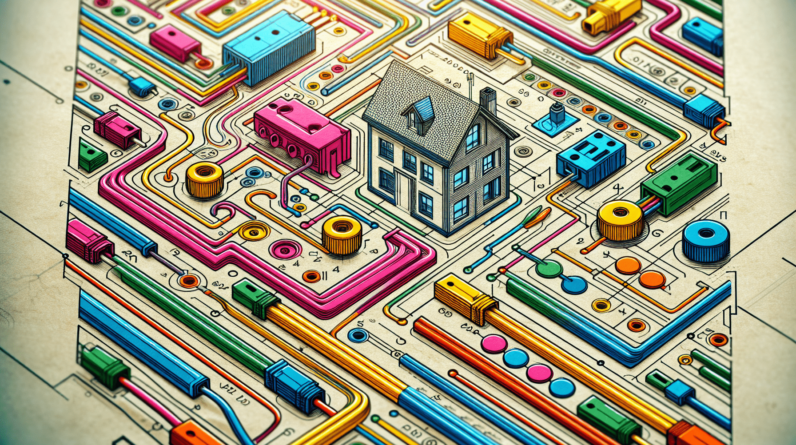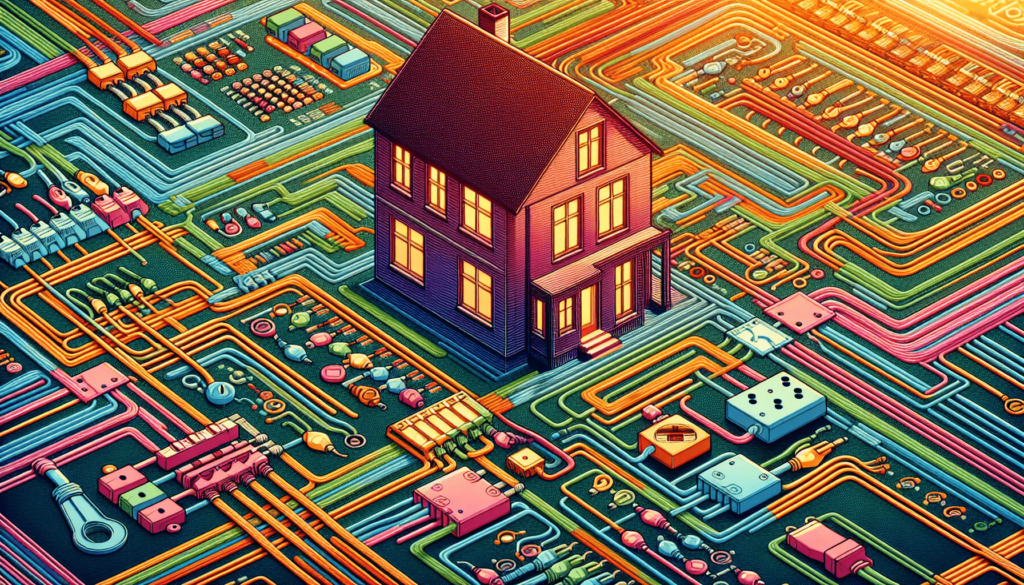

Have you ever wondered how electricity flows through your home? Understanding the electrical diagram of house wiring can illuminate the intricate relationships between various components, ensuring your house remains powered safely and effectively. Let’s break this down in a way that makes it easy for you to grasp the essential concepts.
What is an Electrical Diagram?
An electrical diagram, often referred to as a schematic diagram, is a representation of an electrical system. It shows how electrical components like outlets, switches, and lighting fixtures are interconnected and how they relate to the main power source. These diagrams are essential for anyone looking to understand or perform electrical work safely in their home.
Why Do You Need an Electrical Diagram?
Knowing how to read and interpret an electrical diagram can help you in several ways. Whether you’re considering a DIY project or simply want to identify electrical issues in your home, a sound understanding of these diagrams can save you time and money. Moreover, they ensure your electrical system operates safely and efficiently.
Common Symbols Used in Electrical Diagrams
Understanding the symbols used in electrical diagrams is critical for anyone looking to interpret these diagrams successfully. Here’s a quick rundown of common symbols:
| Symbol | Description |
|---|---|
| ⚫ (Circle) | Light fixture or bulb |
| ⏚ (Line) | Power source or wire connection |
| ⏧ (Square) | Outlet |
| ⏻ (Switch) | Switch or control for light |
| ⬤ (Dot or filled circle) | Connection point or node |
Reading Electrical Symbols
While symbols may seem foreign at first, becoming familiar with them is crucial. Each symbol has a specific meaning, making it easier for you to visualize how components are arranged in your home’s wiring. The next step is learning how these symbols relate to each other on a diagram.

Basic Components of House Wiring
Every house wiring system consists of several key components that work together to distribute electricity throughout your home. Understanding these components is vital as you navigate electrical diagrams.
Main Electrical Panel
The main electrical panel, also known as the breaker box, is where the electrical journey begins. It houses circuit breakers that protect your home from overloads and short circuits. Each breaker corresponds to a different circuit within your home.
Service Entrance
This is where electricity enters your home from the utility company’s grid. It consists of various components, such as the service drop, meter, and disconnect switch.
Circuits
Circuits are pathways through which electricity flows. In your home, you typically will find two types of circuits: lighting circuits and power circuits. Lighting circuits often contain several fixtures, while power circuits supply outlets and larger appliances.
The Layout of House Wiring
Understanding the layout of house wiring can further clarify how various components interact with one another. Usually, the wiring follows a specific pattern that adheres to electrical codes.
Wiring Methodologies
In residential construction, two common wiring methodologies are used: Romex and Conduit.
- Romex: This is a type of non-metallic sheathed cable widely used for residential wiring. It contains insulated conductors and is typically easier to work with.
- Conduit: Conduit systems consist of tubes that protect the wires and require more labor to install but provide superior physical protection.
Layout Patterns
Typically, the wiring layout involves running wires horizontally and vertically along walls and between floors. This design helps you map out how power travels from the panel to the various fixtures throughout your home.

Creating a Basic Electrical Diagram for Your Home
Creating an electrical diagram of your home doesn’t have to be a daunting task. It can be a simple process that provides clarity about your wiring setup and helps identify areas in need of upgrade or repair.
Steps to Create Your Diagram
- Gather Your Tools: Get graph paper, a pencil, and a ruler. You may also want to use software like AutoCAD or an online diagram tool for digital drawings.
- Map Your Home Layout: Begin by sketching the layout of your home, marking walls, doors, and windows.
- Identify Electrical Components: Next, mark where the main panel, outlets, switches, and fixtures are located.
- Draw Connections: Use the appropriate symbols to connect the components. This will create a visual representation of your electrical setup.
Example of a Simple Electrical Diagram
| Component | Symbol |
|---|---|
| Light fixture | ⚫ |
| Wall outlet | ⏧ |
| Switch | ⏻ |
| Circuit breaker | ⚫(with a line) |
This example gives you a basic idea of how to begin wiring different components in your home. It’s straightforward but effective enough for you to visualize where everything fits together.
Understanding Electrical Circuits
Electricity operates in circuits, which are closed loops that allow electrical flow. Having a basic understanding of how these circuits operate can help you troubleshoot and maintain your home’s electrical system.
Types of Circuits
- Series Circuits: In a series circuit, components are connected one after another. If one component fails, the entire circuit will stop working.
- Parallel Circuits: In a parallel circuit, multiple paths exist for the current to flow. If one component fails, the others can still operate, making this a more reliable setup for home wiring.
Circuit Ratings
Understanding circuit ratings is essential to ensure you are not overloading any circuit in your home. Each circuit breaker in your panel has a specific rating measured in amperes (amps). Knowing these ratings can help you avoid tripped breakers or electrical fires.
Wiring Diagrams vs. Schematic Diagrams
It’s important to understand that not all electrical diagrams serve the same purpose. While you may often hear about wiring diagrams and schematic diagrams, they have distinct differences.

Wiring Diagrams
A wiring diagram visually represents the physical layout of electrics. It showcases the actual positioning and connections of cables and devices in your home, making it more practical for installations and troubleshooting.
Schematic Diagrams
Schematic diagrams are more abstract and represent the electrical flow through various components rather than their physical locations. This type of diagram focuses on how circuits are connected and the relationships between different parts of the system.
Safety First: Important Precautions
When dealing with electrical systems, safety should always be your top priority. Understanding safety protocols and precautions can prevent accidents and ensure your peace of mind.
Key Safety Tips
- Turn Off Power: Always turn off the power at the breaker before beginning any electrical project.
- Use Proper Tools: Invest in quality tools certified for electrical work, such as a multimeter or insulated screwdrivers.
- Don’t Overload Circuits: Be mindful of devices you connect to an outlet to prevent overloading circuits, which can lead to fires.
Personal Protective Equipment (PPE)
Using PPE like insulated gloves and goggles can protect you from electrical shocks while working on circuits. When in doubt, consult a professional electrician.
Common Electrical Problems
Understanding common electrical problems can help you identify issues quickly and take corrective action.
Frequent Issues
- Tripping Breakers: If your breaker trips often, it could indicate an overloaded circuit or a short circuit somewhere in your system.
- Flickering Lights: Flickering lights can signal poor wiring, loose connections, or issues with the fixture itself.
- Dead Outlets: If an outlet stops working, it may be due to a tripped breaker or a faulty connection within the circuit.
Troubleshooting Techniques
- Test for Voltage: Use a multimeter to check for voltage at dead outlets or fixtures.
- Inspect Wires: Look for any visible damage or frayed wires in your system.
- Reset Breakers: Sometimes a simple reset of the breaker can solve the issue, but don’t rely on this alone as a long-term fix.
Hiring an Electrician
While many electrical jobs can be tackled as DIY projects, some may require the expertise of a qualified electrician. Understanding when it’s best to call in a professional can spare you from costly mistakes.
Signs You Need an Electrician
- Complex Wiring: If your wiring system is too convoluted or extensive for you to understand comfortably, it’s time to call in an expert.
- Frequent Electrical Problems: Regularly experiencing electrical issues can signal an underlying problem that requires professional evaluation.
- Renovations: Any significant changes to your home, such as additions or full renovations, typically need to adhere to electrical codes that professionals are trained to follow.
Choosing the Right Electrician
When you decide to hire an electrician, ensure they are licensed, insured, and have good references. It’s worth checking local reviews and asking for estimates before settling on a contractor.
Conclusion
Understanding electrical diagrams for house wiring is invaluable for maintaining safety and efficiency within your home. By familiarizing yourself with the key components, symbols, and common practices, you can empower yourself to tackle electrical projects more confidently. Whether it’s a simple repair or a complete overhaul, having this knowledge at your fingertips will not only enhance your understanding but also your home’s electrical system.
Learning about house wiring doesn’t have to be intimidating. With patience and practice, you will gain the confidence to manage your home’s electrical needs effectively.






